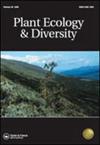páramo三种金丝桃属植物的生境偏好及干旱脆弱性
IF 1.6
4区 生物学
Q2 PLANT SCIENCES
引用次数: 1
摘要
Páramos是热带高山生态系统,气候变化预计会对植物生长、生态系统结构、生态系统功能和生态系统服务提供造成未知的后果。目的量化环境因子(非生物因子和生物因子)与páramo三种常见金丝桃属植物空间分布的关系及其对干旱的生理脆弱性。方法沿湿度梯度对10个样地的土壤含水量、土壤温度和植被覆盖度进行记录。此外,我们测量了一系列与干旱致死风险相关的生理特征。结果研究发现,高叶红和刺柏主要生长在土壤含水量高、植被覆盖度高的地区。这两个物种有更宽的木质部导管,表现出各向异性行为,同样容易受到空化的影响,对水力破坏的安全边际很低。墨西哥蕨生长在植被覆盖少、土壤含水量低、土壤温度高的地方。墨西哥人表现出一种不同的策略,可能使它在这些条件下茁壮成长;它在中午保持较高的水势值,木质部血管较窄,使其不易发生空化。结论páramo三种金丝桃的分布基本响应土壤含水量,符合金丝桃应对水分亏缺的生理机制。如果未来更长时间的干旱变得更加普遍,来自潮湿栖息地的金丝桃物种可能会减少。本文章由计算机程序翻译,如有差异,请以英文原文为准。
Habitat preference and vulnerability to drought of three Hypericum species of the páramo
ABSTRACT Background Páramos are tropical alpine ecosystems where climate change is expected to cause yet unknown consequences for plant growth, ecosystem structure, ecosystem function and the provision of ecosystem services. Aim To quantify the relationship between environmental factors (abiotic and biotic) and the spatial distribution of three common Hypericum species in the páramo and their physiological vulnerability to drought. Methods We recorded soil water content, soil temperature, and vegetation cover in 10 plots along a moisture gradient. Additionally, we measured a series of physiological traits associated with the risk of drought-induced mortality. Results We found that H. goyanesii and H. juniperinum mainly grew in areas with high soil water content, and similar high vegetation cover. These two species had wider xylem vessels, showed anisohydric behaviour and were equally vulnerable to cavitation with low safety margins against hydraulic failure. H. mexicanum grew in places with less vegetation cover, lower soil water content, and higher soil temperatures. H. mexicanum showed a different strategy that probably allows it to thrive in these conditions; it maintains high values of water potential at noon and has narrower xylem vessels, making it less vulnerable to cavitation. Conclusion The distribution of the three Hypericum species in the páramo responds essentially to soil water content, in line with the physiological mechanisms of the species to cope with water deficit. Hypericum species from moist habitats could decline if longer drought episodes become more common in the future.
求助全文
通过发布文献求助,成功后即可免费获取论文全文。
去求助
来源期刊

Plant Ecology & Diversity
PLANT SCIENCES-
CiteScore
3.30
自引率
0.00%
发文量
26
审稿时长
3 months
期刊介绍:
Plant Ecology and Diversity is an international journal for communicating results and novel ideas in plant science, in print and on-line, six times a year. All areas of plant biology relating to ecology, evolution and diversity are of interest, including those which explicitly deal with today''s highly topical themes, such as biodiversity, conservation and global change. We consider submissions that address fundamental questions which are pertinent to contemporary plant science. Articles concerning extreme environments world-wide are particularly welcome.
Plant Ecology and Diversity considers for publication original research articles, short communications, reviews, and scientific correspondence that explore thought-provoking ideas.
To aid redressing ‘publication bias’ the journal is unique in reporting, in the form of short communications, ‘negative results’ and ‘repeat experiments’ that test ecological theories experimentally, in theoretically flawless and methodologically sound papers. Research reviews and method papers, are also encouraged.
Plant Ecology & Diversity publishes high-quality and topical research that demonstrates solid scholarship. As such, the journal does not publish purely descriptive papers. Submissions are required to focus on research topics that are broad in their scope and thus provide new insights and contribute to theory. The original research should address clear hypotheses that test theory or questions and offer new insights on topics of interest to an international readership.
 求助内容:
求助内容: 应助结果提醒方式:
应助结果提醒方式:


